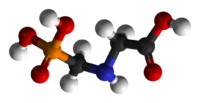
Photo from wikipedia
BACKGROUND Glyphosate is a broad-spectrum biocide and the active ingredient in the most widely used herbicides worldwide. Since 2015, when the International Agency for Research on Cancer classified it as… Click to show full abstract
BACKGROUND Glyphosate is a broad-spectrum biocide and the active ingredient in the most widely used herbicides worldwide. Since 2015, when the International Agency for Research on Cancer classified it as a Class 2A carcinogen, global interest in this chemical spiked particularly as regards exposure of the general population. OBJECTIVE An exploratory glyphosate exposure assessment was conducted among Portuguese adults. METHODS Self-selected participants provided first morning urine which was tested for glyphosate and its metabolite aminomethylphosphonic acid (AMPA) at two distinct periods of time, by two different laboratories. RESULTS In the first round of testing 28% and 50% presented detectable levels of glyphosate and AMPA respectively, with median values of 0.25 and 0.16 µg/L. Systematically available internal dose values were 8.20E-06 mg/Kg (glyphosate) and 5.04-05 mg/Kg (AMPA). In the second round 73% and 97% presented detectable levels of glyphosate and AMPA respectively with median values of 0.13 and 0.10 µg/L. Systematically available internal dose values were 4.00E-06 mg/Kg (glyphosate) and 3.00E-06 mg/Kg (AMPA). CONCLUSIONS Glyphosate exposure was detected among Portuguese adults, with percentages of glyphosate and AMPA contaminated urine in both rounds of testing and above values from previous studies in other European countries. Systematically available internal doses values are below EFSA's risk assessment values (ADI or AOEL), and as such, the concentration values measured in this study are not per se a human health problem. Even though there were study limitations, it is the first assessment in Portugal and contributes to the overall knowledge map of glyphosate exposure in Europe.
Journal Title: Environmental toxicology and pharmacology
Year Published: 2020
Link to full text (if available)
Share on Social Media: Sign Up to like & get
recommendations!